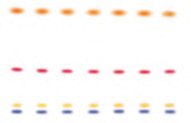TLC Silica Gel 60 G Plates with Gypsum
The TLC silica gel 60 G plates consist of silica gel having a pore size of 60 Å as the adsorption formulation, with gypsum as a binder material. Gypsum is incorporated in the silica gel in the form of calcium sulfate hemihydrate (1/2CaSO4).
Our highly robust TLC silica gel plates with gypsum as binder, are recommended for customers working in QA/QC labs using European Pharmacopoeia (Ph. Eu.) monograph methods. As these customers specifically require TLC plates with gypsum and do not wish to use classical TLC plates, having organic binders for their analysis.
The plates exhibit complete compliance with the International Pharmacopoeia and have been mentioned in about 200 monograph methods described in the European Pharmacopoeia (Ph. Eu.). These TLC silica gel 60 G plates satisfy the TLC performance test requirements of European Pharmacopoeia, in addition to our in-house standard QC tests, proving their premium quality.
The TLC performance test is a chromatographic separation, which involves the application of an appropriate (10 μL for a normal TLC plate and 1 μL to 2 μL for a fine particle size plate) volume of TLC performance test solution R (Reagent 1116600) to the plate. The plate is then left for development to a length equal to two thirds of the plate height, in the mobile phase consisting of 20 volumes of methanol R and 80 volumes of toluene R. Successful development of four clearly separated spots, indicates a positive result. The spot of bromocresol green with an Rf value less than 0.15, the spot of methyl orange with an Rf value in the range of 0.1-0.25, the spot of methyl red with an Rf value in the range of 0.35-0.55, and finally the spot of Sudan red G with an Rf value in the range of 0.75-0.98.

Figure 1.Chromatogram of TLC Silica Gel 60 G plates in the Ph. Eur. performance test
The development of four clearly separated spots, with Rf values within the prescribed range indicate the promised quality of our silica gel G TLC plates.
Identification Test for Atenolol and Chlorthalidone in Tablets Following European Pharmacopeia Monograph
Atenolol is a selective β1 receptor antagonist, belonging to the group of beta blockers, a class of drugs used primarily in cardiovascular diseases.
Chlorthalidone is a diuretic drug used to treat hypertension, originally marketed as Hygroton in the USA. It is described as a thiazide diuretic, and often used in the management of hypertension and edema.
With this application note we illustrate how silica gel G F254 plates are suitable for analysis of Atenolol and Chlorthalidone in a combination drug following the experimental conditions per the European Pharmacopeia identification TLC test for Atenolol (version 9.0).

Figure 2. TLC chromatogram for the identification of Atenolol and Chlorthalidone in combined tablets
To continue reading please sign in or create an account.
Don't Have An Account?